SEO Vs. SEM: Comprehending the Secret Distinctions
On the planet of electronic marketing, two essential approaches that commonly come up are SEO and SEM. While they might sound comparable, they in fact offer various purposes and have unique strategies. SEARCH ENGINE OPTIMIZATION, which means Seo, focuses on enhancing an internet site's visibility and natural position on online search engine results web pages. On the various other hand, SEM, or Online Search Engine Advertising, entails paid marketing to increase an internet site's exposure on online search engine. Comprehending the crucial distinctions between search engine optimization and SEM is vital for companies wanting to maximize their on the internet presence and drive traffic to their web sites. In this write-up, we will explore the meanings, purposes, and crucial components of both search engine optimization and SEM, losing light on their unique features and benefits.

Meaning of SEO
SEO, or Look Engine Optimization, refers to the practice of maximizing web sites to improve their exposure and positions on search engine results web pages (SERPs) It includes various methods and techniques focused on enhancing organic, or non-paid, web traffic to an internet site. The ultimate objective of search engine optimization is to boost a web site's online existence and draw in more targeted visitors.
Among the essential facets of search engine optimization is keyword optimization (https://podcasts.apple.com/us/podcast/scalable-link-building-improve-organic-rankings-for/id1512707750?i=1000637344933). When looking for info or items associated to a particular site, this involves conducting detailed study to recognize relevant search phrases that customers are most likely to browse for. By integrating these keyword phrases purposefully into the web site's content, meta tags, and Links, SEO intends to enhance the site's significance and position for those certain search terms
Another vital aspect in SEO is on-page optimization. This involves enhancing various elements on a website, such as title tags, headings, photos, and inner web links, to make them even more search engine-friendly (link building). By ensuring that these components are appropriately structured and appropriate to the website's content, search engine optimization helps internet search engine understand the context and importance of the website
Furthermore, SEO also includes off-page optimization methods, such as web link structure. This entails getting top notch backlinks from various other credible sites, which indicates to online search engine that the site is reliable and authoritative. By building a strong network of backlinks, SEO boosts an internet site's credibility and improves its possibilities of ranking higher in search engine result.
Interpretation of SEM
SEM, or Search Engine Advertising, is an advertising strategy that includes advertising sites and increasing their presence via paid advertising on search engine results web pages (SERPs) Unlike search engine optimization, which concentrates on maximizing websites to enhance organic search positions, SEM uses paid marketing to drive web traffic to an internet site.
One of the crucial components of SEM is pay-per-click (PPC) advertising and marketing. When a user searches for those key words, the advertisements show up at the leading or side of the search results.

SEM likewise consists of various other kinds of paid advertising, such as display screen ads, remarketing ads, and shopping ads. Display ads are banners or aesthetic advertisements that show up on web sites within the Google Display Network. Remarketing advertisements target users that have actually formerly gone to a site, offering them advertisements as they surf other websites. Buying advertisements, on the various other hand, advertise particular items and present relevant details, such as price and availability.
Goals of Search Engine Optimization and SEM
The goals of both search engine optimization (SEARCH ENGINE OPTIMIZATION) and online search engine advertising and marketing (SEM) focus on raising a web site's presence and driving targeted traffic. However, the strategies and techniques employed by each differ significantly.
The main goal of SEO is to enhance a web site's natural search position on internet search engine results web pages (SERPs) This is accomplished by maximizing various components on the site, such as web content, meta tags, and website framework, to make it extra enticing and pertinent to internet search engine. By doing so, SEO aims to bring in more organic traffic from users actively looking for relevant keywords or topics.
On the other hand, SEM concentrates on boosting an internet site's presence with paid advertising and marketing on online search engine. The main objective of SEM is to drive targeted website traffic to a web site by bidding process on key words and displaying advertisements in online search engine outcomes. This method enables organizations to get to a larger target market swiftly and efficiently.

Trick Components of SEO
To effectively carry out SEO, it is essential to understand the crucial elements that contribute to improving a website's organic search ranking. These parts can be broadly classified into on-page factors and off-page factors.
On-page variables describe the components that are straight existing on a website and can be enhanced for far better internet search engine visibility. This consists of the internet site's web content, keyword usage, meta tags, URL structure, page titles, and headings. By enhancing these components, internet search engine can much better comprehend the importance and context of the site's material, causing higher rankings.
Off-page elements, on the other hand, focus on external signals that influence a site's authority and trustworthiness. This includes backlinks from other reputable internet sites, social networks signals, and online points out (https://suarakl.com/news/linkdaddy-announces-agency-backlink-local-business-directory-listings-service/458323). The more top notch and click this pertinent backlinks a website has, the far better its opportunities of placing higher in search engine results pages
Additionally, individual experience is a crucial element of SEO. Linkdaddy. Look engines prioritize websites that use a positive customer experience, including rapid packing times, mobile-friendliness, and easy navigating
Key Parts of SEM
In comparison to search engine optimization, SEM encompasses an unique collection of crucial parts that concentrate on paid advertising and driving instant presence in online search engine outcomes. These elements consist of internet search engine advertising, additionally referred to as pay-per-click (PPC) marketing, keyword study, advertisement creation, and campaign administration.
Browse engine advertising and marketing is an important part of SEM. When those keywords are looked, it entails bidding process on key words pertinent to your business and developing message or display ads that will certainly show up in search engine results. With internet search engine advertising, you can target specific demographics, areas, and also time of day to reach your preferred audience.
Keyword study is an additional essential element of SEM. It involves identifying the keyword phrases that your target audience is using to search for services or items similar to yours. By carrying out extensive keyword research, you can maximize your ads and ensure they are revealed to the right people at the appropriate time.
Ad production is the process of creating influential and compelling advertisements that will attract individuals to click them. Well-crafted advertisements have a strong call-to-action, appropriate messaging, and a clear value suggestion.
Lastly, project management includes tracking and maximizing your SEM campaigns to ensure they are executing efficiently. This includes tracking metrics such as click-through prices, conversion prices, and roi (ROI) to make data-driven decisions and accomplish the ideal outcomes.
Final Thought
To conclude, search engine optimization and SEM are 2 unique methods in digital marketing. Search engine optimization focuses on enhancing websites to boost natural search rankings, while SEM entails paid marketing to enhance presence on internet search engine results web pages. Both techniques have their own purposes and crucial components that add to their effectiveness. Comprehending the differences in between search engine optimization and SEM is important for businesses to create a detailed internet marketing technique.
SEO, which stands for Browse Engine Optimization, concentrates on boosting a site's exposure and natural position on search engine results web pages. On the various other hand, SEM, or Search Engine Marketing, involves paid marketing to enhance a site's exposure on search engines (link building).SEO, or Look Engine Optimization, refers to the practice of maximizing internet sites to enhance their presence and positions on search engine results web pages (SERPs)The major objective of Search engine optimization is to enhance a web site's natural search position on search engine results pages (SERPs) SEO concentrates on maximizing websites to boost natural search positions, while SEM includes paid advertising to increase visibility on search engine results pages